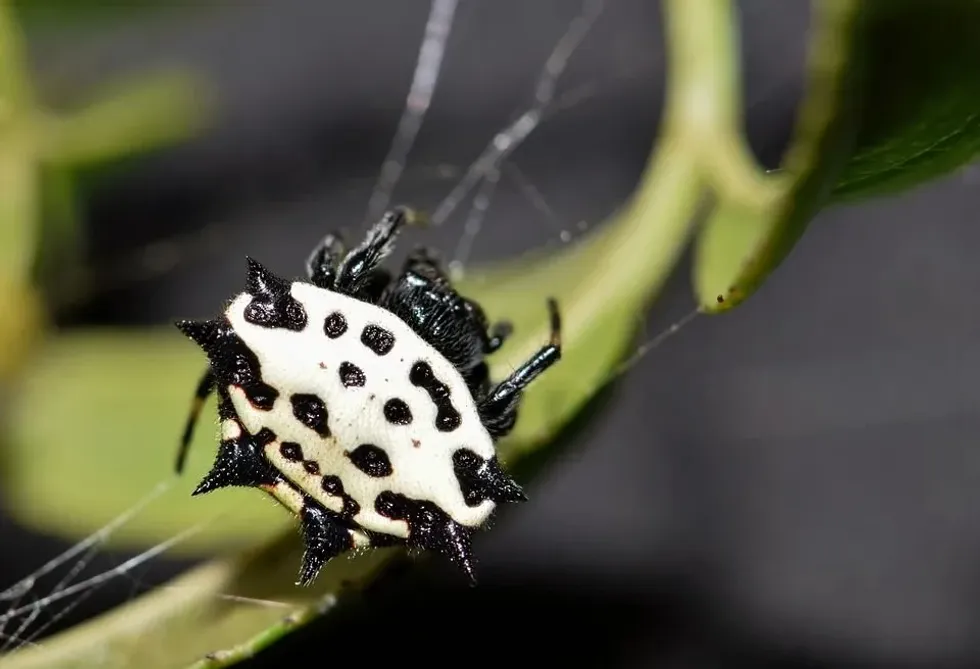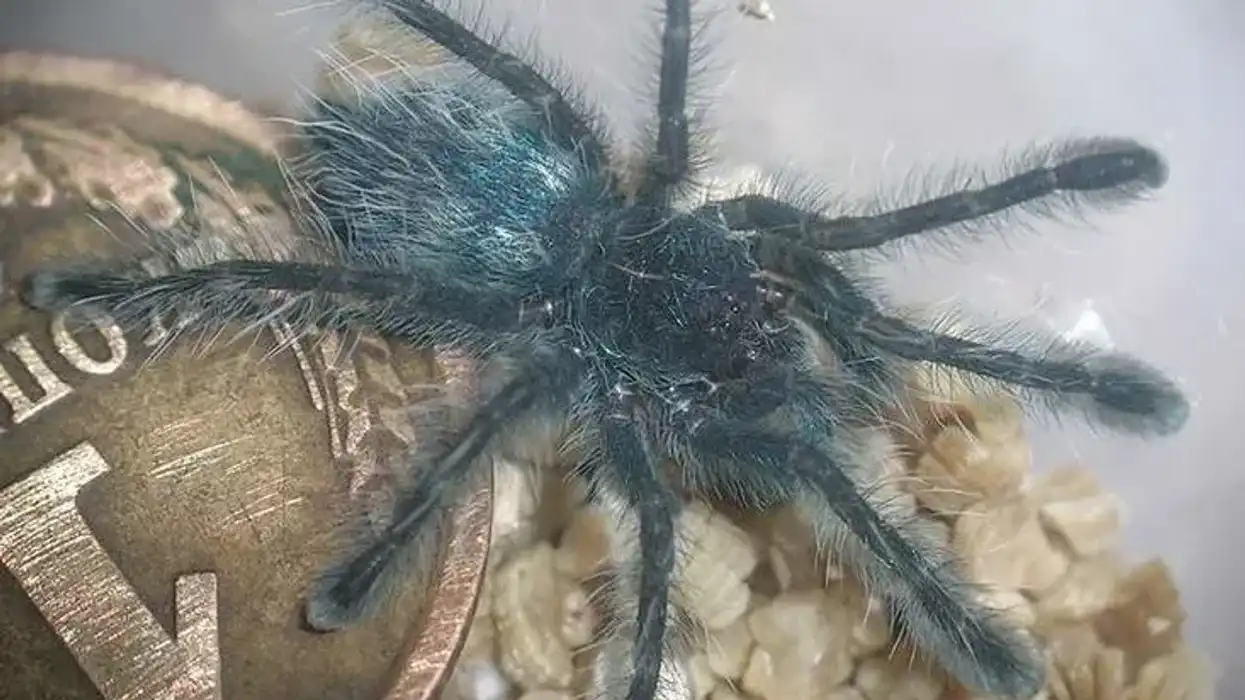The spiny orb-weaver (Gasteracantha cancriformis), also known as spiny spiders, are colorful spiders found in different colors like black, white, and yellow with red spines and white spots on their back. Due to their unusual body shape, they are sometimes called a 'crab spider', but they are not related to the crab species.
A female spiny orb-weaver is always larger than males in size, and the female lifespan is also longer than that of males. A male spiny orb-weaver dies after the mating process, and the female feeds on him.
After that, the female continues to live for some weeks and produces eggs, and then she hangs the egg sac on webs under leaves to indicate that she is done with laying eggs and has completed the breeding process.
After that, the female takes care of her offspring for a few days, and then she also dies. This is the typical lifecycle of the spiny orb-weaver, and its lifespan is about one year in total.
Here on our page, we have lots of interesting facts on spiny orb-weaver spiders for everyone to enjoy. Let's have a look at these interesting facts and if you do like these, you can read our green stink bug and Io moth facts too.
Spiny Orb-Weaver Interesting Facts
What type of animal is a spiny orb-weaver?
A spiny orb-weaver is a species of easily distinguished spiders, thanks to their colorful appearance and red-colored spine.
What class of animal does a spiny orb-weaver belong to?
Spiny orb-weaver spiders are a species of spiders who belong to the family of arthropod and the class of Arachnida.
How many spiny orb-weavers are there in the world?
The exact population of spiny orb-weavers is scientifically unknown as relevant studies are yet to be conducted. They are listed as under Least Concern which means we need not worry about any population decline.
There are 70 different species of spiny orb-weaver spiders and 33 subspecies that have been found to this date. The most common species is Gasteracantha cancriformis, also known as the spiny-backed orb-weaver.
Where does a spiny orb-weaver live?
The spiny-backed orb-weaver (Gasteracantha cancriformis) or the crab-like orb-weaver is found worldwide but mostly in California in the U.S. and in a few parts of Asia.
What is a spiny orb-weaver's habitat?
Spiny-backed orb spiders prefer to find a habitat in woodland areas and are mostly found on the leaves of trees. They are also found in shrubby gardens, woodlands, or on citrus groves where they make their webs and wait for small insects to become trapped on them so that they can feed on them.
Who do spiny orb-weavers live with?
This arthropod is a solitary animal that lives alone throughout its lifespan. These insects gather only when they mate, and after the mating process, the males die while the females live. Females produce eggs and make an egg sac in the underside of the leaves where their web is.
How long does a spiny orb-weaver live?
The average life cycle of a spiny orb-weaver spider (Gasteracantha cancriformis) is approximately one year long. Males crab-like spiny orb-weaver spiders die just days after mating, and females live longer so that they can lay their eggs and feed their offspring.
How do they reproduce?
The spiny orb-weaver (Gasteracantha cancriformis) mostly breeds from October to January. During this time, males vibrate to attract females, and then they embrace each other for the mating process.
When the mating process is finished, the male dies and the female stays on the web for a few weeks where she lays an egg mass in the egg sac. After taking care of these eggs for a few days, she dies.
What is their conservation status?
The spiny orb-weaver (Gasteracantha cancriformis) currently has a status of Least Concern according to the International Union for the Conservation of Nature (IUCN). Their population is currently under control with no major unmanageable threats.
It is also worth noting that these insects lay an egg mass of hundreds of spiders at once, which helps counter any possible reduction in their population.
Spiny Orb-Weaver Fun Facts
What do spiny orb-weavers look like?
The spiny-backed orb weaver spider is a very bright, colorful spider that has yellow, white, and black colors on its body with red spines that are very unique and look attractive. These spiders tend to have black or white spots on their body and have eight legs.
How cute are they?
Whether they are cute or not is subjective, but these spiders are not venomous, and because of that and their attractive features, some people keep them as pets.
How do they communicate?
The crab-like orb-weaver communicates with other spiders through vibrations. These vibrations are also known as seismic communication, by which they warn each other about threats and court each other. They also mimic the vibrations of different insects to catch their prey.
How big is a spiny orb-weaver?
The average length of spiny orb-weaver spiders is 0.06-0.4 in ( 1.5-9.5mm). These spiders are ten times smaller than a common bird.
How fast can spiny orb-weavers move?
Spiny orb-weaver spiders can run up to 1.5 ft per second (0.46 meters per second) which is less than 1 mph.
How much does a spiny orb-weaver weigh?
The weight of a spiny orb-weaver is about 5.6 oz (160 g). Normally, a male is smaller than a female, and after they die, females feed on males as their prey.
What are their male and female names of the species?
There are no different names for male and female spiny orb-weaver spiders.
What would you call a baby spiny orb-weaver?
There is no particular name for a baby spiny orb-weaver spider.
What do they eat?
Like many other spider species, a spiny orb-weaver spider also feeds on the small insects that they capture in their web. Small insects like mosquitoes, beetles, and moths make up their usual diet.
Sometimes these spiders also catch other spiders as their prey by mimicking the vibration sounds of these other animals. A female spiny orb-weaver spider also feeds on male orb-weavers after they die (after the mating process).
Are they harmful?
The spiny orb-weaver spider is not harmful as they are not venomous, but it can still bite if it feels threatened. Their bites are unlikely to cause serious symptoms so do not look distinctive in any way.
Would they make a good pet?
In theory, you can say that a spiny orb-weaver can be kept as a pet. They will not bite unless they feel threatened so they are sometimes kept as pets because they are not aggressive, and their bites are not poisonous.
The only disadvantage to having a spiny orb-weaver pet is that these spiders live by spinning a massive web and prefer to make their web on the leaves of a tree, especially on citrus groves, so really they belong in the wild.
Did you know...
One of the best spiny orb-weaver spider facts is that there are always tufts of silk on their web, mostly on the foundation lines.
The mating behavior of this species of spider is somewhat formal as the male visits the female on her web and uses a four-tap pattern by drumming on the silk tufts that are scattered on the web to get the attention of the female orb weaver spiders.
After mating, female orb-weaver spiders can store up to 260 eggs in their egg sac.
One of the most interesting spiny-backed orb-weaver spider facts is that these spiders have an anti-predator function on their abdomen which helps them avoid the dangers of getting killed or wounded by predators.
They make large circular webs that are great at catching their prey. Orb-weaver spiders paralyze their prey, let them stay where they are on the web, and feed on them whenever the spiders please.
Male orb-weaver spiders are much smaller than females, and they do not possess prominent spines.
How do spiny orb-weavers protect themselves?
Spiny orb-weavers protect themselves by camouflage. They often hide so perfectly in their surroundings that it is difficult to spot them. They usually hide in leaf litter from their predators and some species of spiny orb-weavers hang their old eggs sacs on their webs under the leaf for extra camouflage.
How to get rid of spiny orb-weavers?
When you find spiny orb-weavers or their spider webs in your house or yard, you should destroy their webs with a stick or broom and let the spider continue to hang on to your stick while taking them out of the yard and then release them.
You don't have to kill them but if you want to kill them, you must do it quickly as they are good at running and hiding.
After removing the spider remember to clean the outdoor window sill or door of your house and the place its web once was so that no other spider can make their webs in that place.
Here at Kidadl, we have carefully created lots of interesting family-friendly animal facts for everyone to discover! Learn more about some other arthropods, including the firebrat or the Jerusalem cricket.
You can even occupy yourself at home by drawing one of our Spiny orb-weaver coloring pages.










